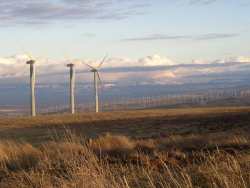
The United States has enough wind resources to provide more than enough electricity than the nation currently uses.
For the first time, a U.S. government agency has cited carbon dioxide emissions as the reason for rejecting an air-quality permit to build coal-fired power plants. Roderick Bremby, secretary of the Kansas Department of Health and Environment (KDHE), explained his October 18 decision saying, “I believe it would be irresponsible to ignore emerging information about the contribution of carbon dioxide and other greenhouse gases to climate change and the potential harm to our environment and health if we do nothing.”
The Kansas decision follows an April U.S. Supreme Court ruling that greenhouse gases can be regulated as pollutants under the Clean Air Act. “There’s still the threat that many of the 150 or so proposed new coal-fired power plants will be built in the U.S.,” notes Worldwatch senior researcher Janet Sawin. “But others are dropping off the drawing board as public opposition, lawsuits, resistance from local and state politicians, and uncertainty about future carbon prices encourage utilities and investors to consider other options.” Florida, Idaho, Iowa, Oklahoma, and Texas are among the states where plans for new coal-fired power plants have been blocked or scrapped.
Some Kansas leaders say Sunflower Electric Power’s plans to build two 700-megawatt coal-fired power plants in Holcomb, Kansas, are needed to provide jobs and energy to the region. The utility company says it will challenge the rejection of the permit. But Kansas Governor Kathleen Sebelius supports the KDHE’s decision and promotes expanding the state’s use of renewable energy sources, especially wind. Kansas is ranked third in the country for wind energy potential, according to the American Wind Energy Association.
In its 2006 report American Energy, Worldwatch reports that renewable energy creates more jobs per unit of energy produced and per dollar spent than fossil fuel technologies. Some experts estimate that every 100 megawatts of wind capacity generates 200 construction jobs, 2 to 5 permanent jobs, and up to $1 million in local property tax revenue. If developed, the wind resources of Kansas, North Dakota, and Texas alone are in principle large enough to meet all of the nation’s current electricity needs, the report notes.
The two Kansas coal-fired plants were projected to emit some 11 million tons of carbon dioxide annually, nearly as much as a group of eight northeastern states hopes to save in total by 2020 through a regional cap-and-trade program. Coal-fired power plants are responsible for 40 percent of all U.S. carbon dioxide emissions and provide about half of U.S. electricity generation, according to Reuters. Currently, coal generates an estimated 75 percent of the power used in Kansas.
This story was produced by Eye on Earth, a joint project of the Worldwatch Institute and the blue moon fund. View the complete archive of Eye on Earth stories, or contact Staff Writer Alana Herro at aherro [AT] worldwatch [DOT] org with your questions, comments, and story ideas.